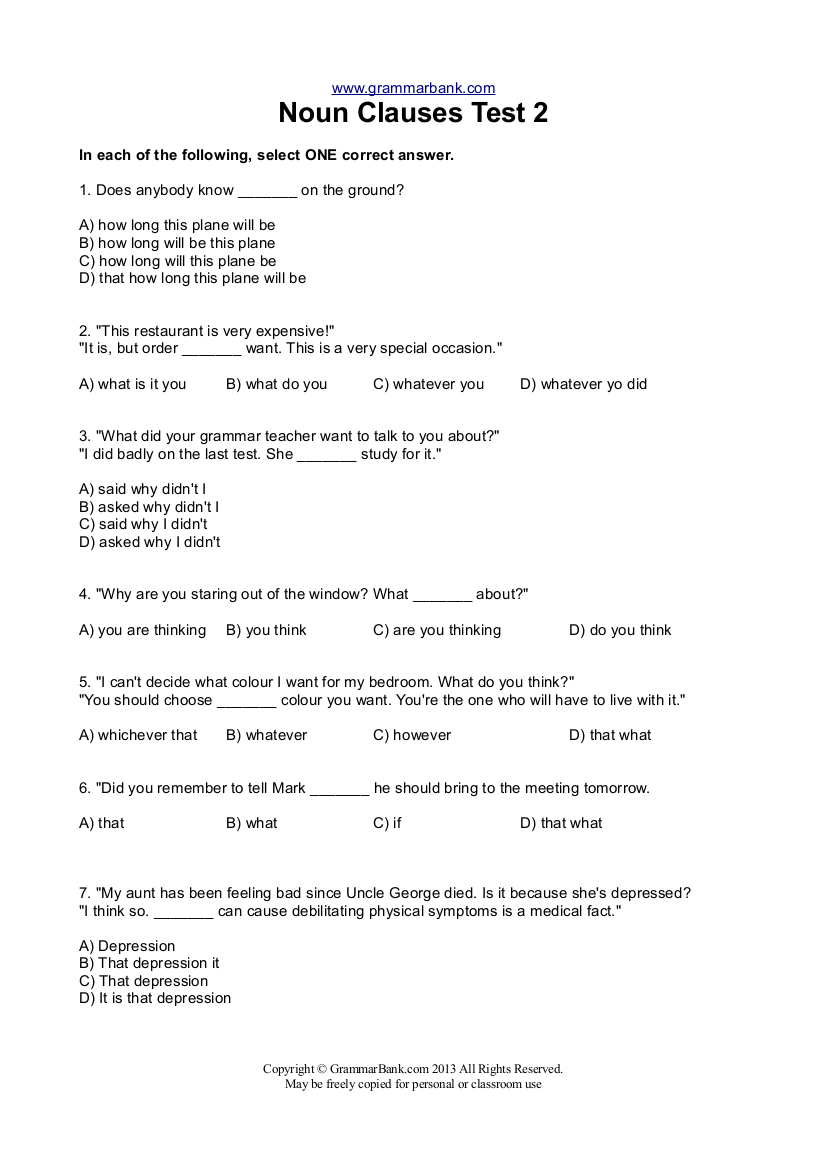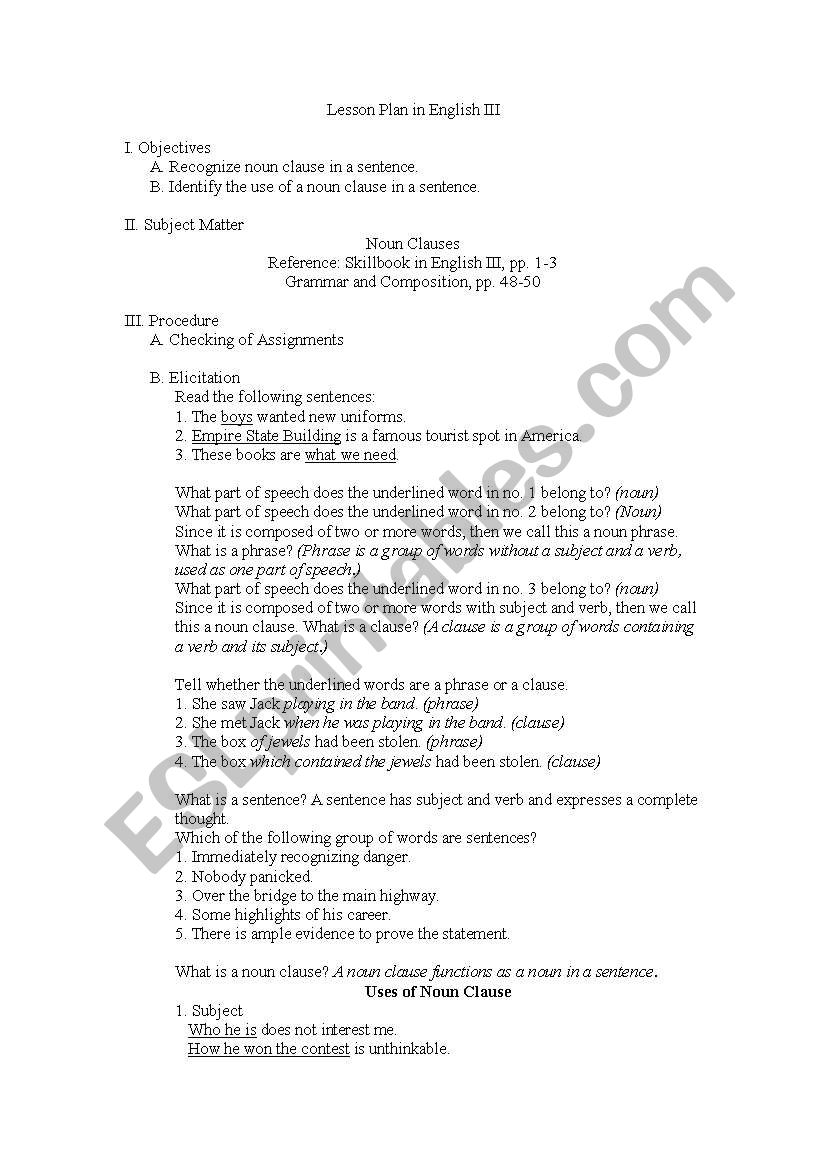In this subject and object pronouns worksheet, students identify and practice using subject and object pronouns. Students start by circling subject pronouns and underlining object pronouns in a dialogue. Next, students match questions with answers and then complete missing subject or object pronouns in the sentences. In the last exercise, students read a text and answer questions in sentence form using one subject pronoun and one object pronoun in each answer. In order to read or download noun adjective adverb clauses exercises answer key bing pdf ebook, you need to create a FREE account.
This engaging subject vs. object pronouns worksheet can be used to help introduce or teach subject and object pronouns. Students begin by identifying subject and object pronouns in sentences. Afterwards, students rewrite sentences by replacing the underlined words in the sentences with subject or object pronouns. Next, students choose the subject or object pronoun in brackets that best completes each sentence and write it in the space provided.
Students then write the word 'subject' or 'object' in the column on the left to indicate the type of pronoun used in the sentence. This leads on to freer practice where students write six sentences of their own using subject and object pronouns. Student A begins by asking their first question to Student B who listens and tries to find the correct response on their worksheet. When Student B finds the correct response, they complete the answer with the appropriate subject or object pronoun and read it back to their partner. If Student A agrees the answer is correct, they write the response in the space next to the question. If Student A thinks an answer is wrong, they ask Student B to try again.
When all the questions have been answered, the students swap roles. Finally, check the correct answers with the class by having students read out their responses. In this entertaining subject and object pronouns game, students race to complete sentences with subject or object pronouns. In groups, the reader turns over a card and reads the sentence aloud to the players using the word 'blank' for the missing pronoun. The players listen and then race to grab the correct pronoun card to complete the sentence. The student with the most cards at the end of the game wins.
In this free subject and object pronouns worksheet, students complete and write sentences with subject and object pronouns. To begin, students complete sentences on the worksheet by changing words in brackets into subject or object pronouns. Next, students write sentences about five classmates using subject and object pronouns. They do this without writing the students' names in the sentences.
Students then take it in turns to read their sentences to the class who listens and tries to guess who the sentences are about. Noun clauses may seem very similar to relative clauses but are different and can be easy to identify. First, other dependent clauses work as adverbs or adjectives; this does not.
Second, remember that a noun clause is the noun of the sentence, whereas a relative clause will be dependent on the noun of the sentence. Finally, a noun clause is always essential to the sentence. There are times that a relative clause can be removed, but a noun clause is the noun and must be present. Naming the function of clauses is as easy as pie in this seventh-grade grammar worksheet!
The Adjective, Adverb, and Noun Clauses worksheet begins with a brief introduction to each type of clause, along with examples and explanations. In this subject and object pronouns game, students play bingo by listening to gap-fill sentences and matching pronouns with the missing words. The caller reads a gap-fill sentence at random from the caller's sheet, saying the word 'blank' where the subject or object pronoun should go. The players listen to the sentence and check their bingo cards to see if a suitable subject or object pronoun from their card can be used in the sentence.
If so, they cross the pronoun off their bingo card. The first player to cross off all nine pronouns on their card shouts 'bingo' and reads out the pronouns they crossed off. If the pronouns match with the sentences, the student wins the round and scores a point. The students play several rounds with a different student taking on the role of the bingo caller each time. The student with the most points at the end of the game is the winner. In this amusing subject and object pronouns game, students play snap by matching 'Do you like...?
' questions with answers that contain subject and object pronouns. In pairs, both students turn over a card from their pile at the same time. If the question and answer match, the first student to say 'Snap' scores a point. Students then pick up their own cards, shuffle the pack and play again.
Students do not pick up their partner's cards. If the question and answer don't match, students continue turning over cards until a matching pair comes up and someone says 'Snap'. If a student says 'Snap' when the answer doesn't match the question, the other student scores a point and the game continues.
The first student to get ten points wins the game. In this fun subject and object pronouns game, students match and replace underlined words in sentences with subject or object pronouns. In pairs, students take it in turns to turn over one sentence card and one pronoun card. The student then keeps the two cards and has another turn. If the cards don't match, the student turns them back over. The student with the most pairs of cards at the end of the game wins.
In this communicative subject and object pronouns activity, students give opinions about people, places and things. Students think of people, places and things they love, like, don't mind, dislike or hate and write an answer under each heading on the worksheet. ' For example, 'What do you think of Will Smith? ' Their partner replies by giving their opinion using subject and object pronouns, e.g. 'I like him. He's really good'.
Encourage the students to give their own opinion in return and ask for explanations where possible. When everyone has finished, students give feedback to the class on their preferences. A relative clause is an adjective clause that describes a noun.
A noun clause acts as the noun in the sentence. It can be the subject or object of the verb, object of preposition, or an adjective complement. In this free object pronouns game, students complete sentences with object pronouns.
In pairs, students take it in turns to read each sentence to their partner using the word 'blank' for the missing object pronoun. Their partner listens and then repeats the sentence back, adding in a suitable object pronoun from the box on their worksheet. For each correct answer, students score one point. The student with the most points at the end of the game wins. Attempts have been made to keep the solutions error-free, however, if you find any error, let us know. We'll review it and make corrections if needed.
We need writing to communicate. In writing, it is important to recognize the different types of clauses, or groups of related words. An independent clause is a simple sentence. It contains a subject, verb, and a complete thought. It can stand alone.
A dependent clause is not a complete thought. It is combined with an independent clause to create a complex sentence. There are several different types of dependent clauses, including relative, noun, and adverbial. In this rewarding object pronouns activity, students ask questions about preferences and reply using object pronouns. The aim of the activity is to find someone who has all the same preferences. ' Their classmate looks at the preferences on their card and answers using an appropriate object pronoun, e.g. 'No, I don't like it'.
If so, the two students sit down together. When all the students have found a partner, they give feedback on what preferences they have in common with their partner according to their cards. In groups, students take it in turns to pick up a subject pronoun card and a verb card and mime them to the other group members. To mime the subject pronouns, students indicate with their hand the type of pronoun, e.g. circling their hand for 'we', etc.
The first student to say the correct sentence wins and keeps the two cards. For this activity, identify whether each of the given sentences is an independent or a dependent clause. For sentences that are dependent, specify whether they are relative, noun, or adverbial clauses. To do this, you must right-click and print this page.
With a pencil and an eraser, neatly write your answers in the blank space provided. See if you can determine the function of the hilighted dependent clause in each of the following passages. Revising Sentence Structure The paragraph below consists entirely of simple sentences. To improve its clarity and style, try rewriting it, varying the sentence structures. Follow the directions below. After you finish, rewrite it again, trying different ways of revising some of the sentences.
Use the back of the page. Tracing your family tree can be more than just fun. It might also help save your life. Some serious conditions may be inherited.
These include diabetes, high blood pressure, cancer, and sickle cell anemia. People need to know the facts. They may be at risk for these diseases. Family documents include medical records. These records can show causes of death. You know about your family's medical history.
It can help you safeguard your own health. Combine sentences 1 and 2 to form a compound sentence. Combine sentences 3 and 4 by changing sentence 4 into an adjective clause modifying conditions. Combine sentences 5 and 6 by changing sentence 6 into an adverb clause. Combine sentences 7 and 8 by changing sentence 8 into an adjective clause. Combine sentences 9 and 10 by changing sentence 9 into a noun clause.
Most exercises © Prentice Hall, Inc. And © McDougal Littell Inc. All rights reserved. What is a noun clause? A noun clause is a dependent clause with a noun and a verb that work together to act like a noun in a sentence.
They can be used as subjects or objects. We can eatwhatever you want.How you can choose from this menuis beyond me. In the sentences above "whatever you want" is the direct object of "eat" while "how you can choose from this menu" is the subject of its sentence.
These clauses contain both a subject and verb and act like a noun. Learn how to recognize and understand the role of a noun clause with the practice worksheets below. Grammar is the way we arrange words to make proper sentences. Word level grammar covers verbs and tenses, nouns, adverbs etc.
Sentence level grammar covers phrases, clauses, reported speech etc. The noun clauses part of the site currently has a limited selection of worksheets with a grand total of 11. Other teachers will appreciate your hard work. This worksheet includes some sentences with noun clauses and has a lot of information on other types of clauses and sentence structures too. They would make very good example sentences.
How will this help my writing? Knowing how to identify relative clauses will help you avoid this type of fragment. Remember that complete sentences require a complete thought, and these do not have one. You will want to be sure to join these clauses with an independent one.
In addition, by knowing how to identify relative clauses, you will also know how to punctuate your sentence correctly and avoid a common comma error. 9 ________________, p. English 9 Using Subordinate Clauses to Combine Sentences Combine the following sentences by using adjective or adverb clauses.




























